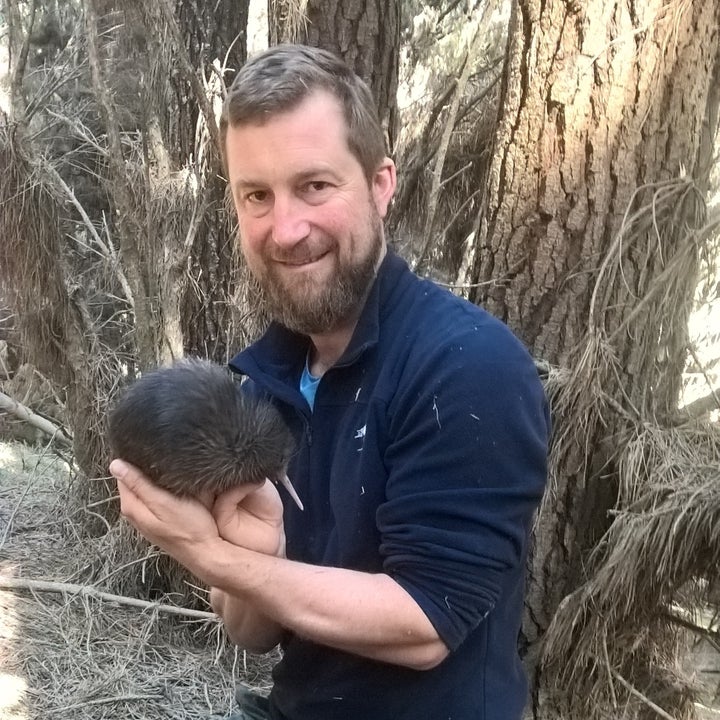
Beau Fahnle holds “Mr. Pitt”: “We actually want feisty birds that fight against us when we handle them. They’ll do better in the wild.”
The Farm Cape Kidnappers, a luxury resort on New Zealand's North Island, sits inside one of the largest wildlife sanctuaries in the country, the Cape Sanctuary. There, efforts are underway to save the native brown kiwi, a small, shy, flightless bird, which has become endangered; its numbers have been decimated by predators introduced to New Zealand by centuries of European immigration. Visitors to the resort can take a walk into the Cape Sanctuary with a guide and hold one of the young birds during a routine checkup. I recently went looking for one of them, named “Mr. Pitt” (no relation, I was told) with Sanctuary Manager Beau Fahnle.
The kiwis in your care are young chicks. How often do you go out to check on them? Is the direction finder you use the only way of locating them, or do you have a map of some kind that gives approximate locations? We generally go out every day and try to “beep” each kiwi chick since they do move around to a new location every night. This may be a matter of feet or even miles; it’s like an ongoing game of hide-and-seek. We try to use certain areas as the creche, or nursery site, that are suitable for the kiwis and also for us finding them again. Depending on how they are doing we will do a health check every one to two weeks. The radio receiver we used to find Mr. Pitt is the only way we can locate him on his individual frequency, which comes from the tiny radio transmitter on his leg. We can’t use GPS to track them since there is currently no way to attach a GPS transmitter that will get the required direction to the sky. We generally creche between 30-50 chicks per year.
The day we went out, you pulled Mr. Pitt out of his nest, or roost, and weighed him. Did you take any other measurements? The weight is the most important data, but we also feel body condition, which is the amount of fat and muscle along the backbone. We also check for visible injuries or abnormalities, vibrancy, signs of attack and check to see that the transmitter is not showing signs of wear. We check the attachment band to see if it is correctly fitted (not too loose or too tight). We need to adjust this as he grows, approximately every three or four weeks.
If a kiwi like Mr. Pitt seems to be in trouble, either medically or from a predator's attack (if he survives it), what emergency measures can you take to save him? Has this happened recently? Yes, this happens from time to time. We have a few options. First, we can do food drops to try and supplement the wild food they are finding. If the weight gets to a critical range we can bring them into a contained pen where we can leave food for them and stop them from wandering around. They are nocturnal, but If they get very hungry in the wild they could start “day walking,” or looking for food. Not only does this increase risk from predation, but it also contributes to them dropping weight since they are not getting the rest they need and using up reserves. Mr. Pitt actually did need to be brought in for supplementary feeding, but he is now back up to a good weight and healthy again, and he has gone out to one of the better parts of the sanctuary to finish his creching period
How did Mr. Pitt end up in that particular nest, in this case under a bunch of pine needles? How small is the radio transmitter on his leg? Mr. Pitt ended up there in his roost all by himself. We have to go out and find him when he is due for his health check. The radio transmitter is quite small, less than an ounce. It is battery operated and it lasts for nine months It needs reattachment regularly since we put them on so if the transmitter fails and we can’t find the bird the attachment band will break off and free the bird.
Do you grow attached to the kiwis you take care of? No, I don’t become attached to them. You can’t afford to in this game. I am fond of them and do my very best to care for them, but I’m always happy to see them go back out to the wild. We only have them for 3-4 months. In my experience people who become too attached to the animals they work with cannot make the best judgements when they bring emotion into it; nature is raw and unforgiving at times, but in that is the beauty it gives us.
Okay, I’ve got to ask: How did Mr. Pitt get his name? They come from the hatchery already with a name. It’s usually is a play on the sire’s name, a bit like naming a racehorse.